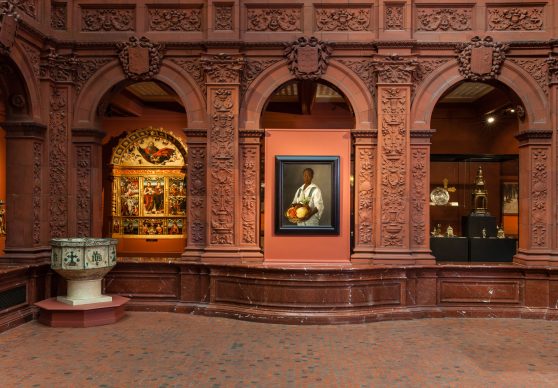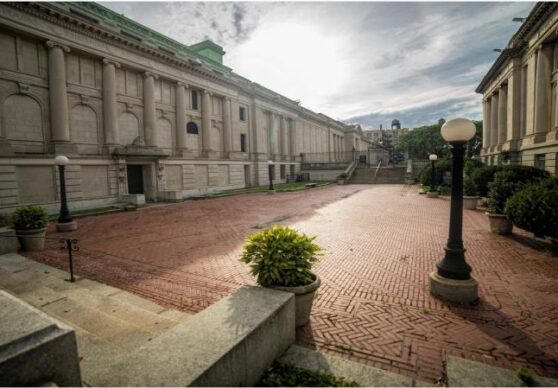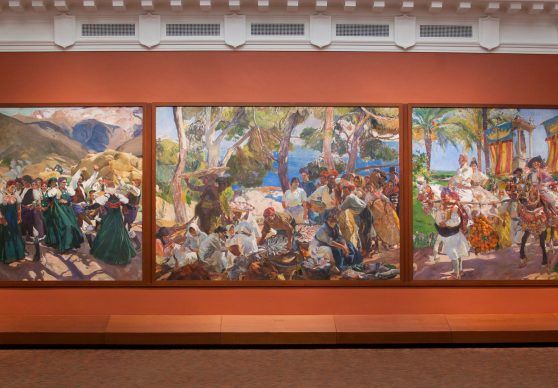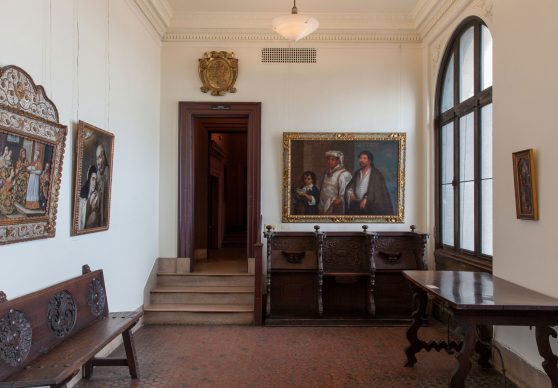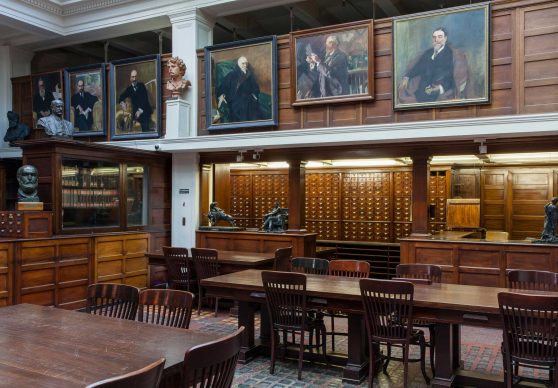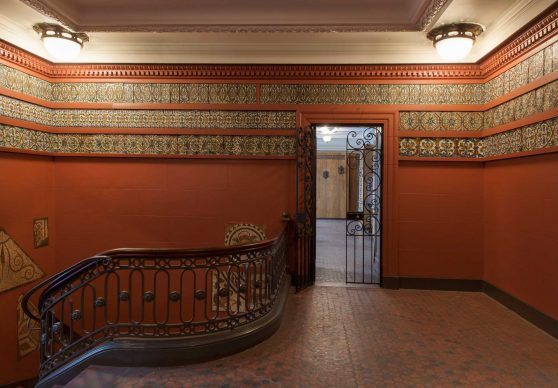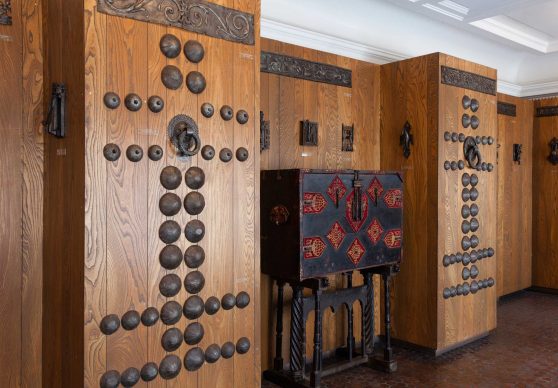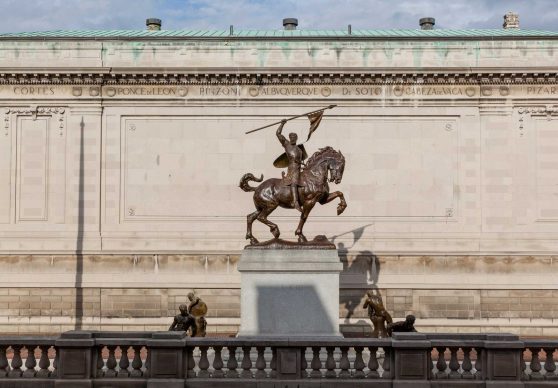Upon entering the Hispanic Society, visitors are brought into a Spanish Renaissance-style courtyard composed of ornate architectural terracotta rising 35 feet high. Made by the Perth Amboy Terra Cotta Company of New Jersey, the designs on the arcade columns are based on the carvings that surround the windows of the early 16th-century patio of the castle of Vélez-Blanco in the province of Almería, now installed at The Metropolitan Museum of Art. Other ornamental features such as the leaf scrolls, grotesques, and Roman trophies were adapted from ornaments typical of the early 16th century, while escutcheons above each arch bear the arms of Spanish provinces and cities.
Recently inaugurated, the East Building Gallery will be open to special exhibitions on a rotating basis. For more information about the hours, please visit .
The gallery houses the monumental series of 14 paintings known as Vision of Spain by the Valencian master Joaquín Sorolla y Bastida, the preeminent artist in Spain at the turn of the 20th century. Archer Milton Huntington, founder of the Hispanic Society, commissioned the paintings in 1911 for a new gallery to be built on the west side of the main building. Sorolla already had been the subject of two enormously successful traveling exhibitions in the United States organized by the Hispanic Society in 1909 and 1911. The 1909 exhibition…
The Spanish Colonial Art Gallery exhibits a selection of Latin American works from the 17th and 18th centuries. Paintings on display include the Virgin of the Immaculate Conception (Mexico, 1640) by the Dominican friar Alonso López de Herrera; The Wedding at Cana (Mexico, 1693) by Nicolás Correa, executed in the enconchado technique, a unique Mexican viceregal art form that incorporates mother-of-pearl fragments with oil painting. A Mexican casta painting from about 1720 by Juan Rodríguez Juárez provides a glimpse into the complex racial structure of viceregal Latin America in which a man, an indigenous woman, and their son are identified with the inscription “de Mestizo y de India…
On exhibition in the Reading Room are a variety of works from the Hispanic Society’s collections. The most exceptional, which dates from the Age of Exploration, is the Map of the World (1526), an enormous portolan chart made in Seville by the chief pilot and cartographer of the House of Trade, Juan Vespucci, nephew of Amerigo Vespucci…
Roman mosaics from the turn of the 3rd century A.D. from Alcolea del Río, located outside of Carmona (Seville) are displayed along the walls of the stairway leading up to the mezzanine. A medallion with the head of Medusa is particularly striking in its vivid rendering of the monster from Greek mythology with a woman’s face and snakes for hair. Above the mosaics and along the walls of the upper foyer are examples of Spanish cuenca tiles of the 16th century. These tiles represent a selection of the Hispanic Society’s holdings of Spanish and Latin American tiles from the fourteenth through the early-twentieth centuries, and serve as a prelude to the Ceramics Gallery.
The Mezzanine provides a survey of five centuries of Spanish painting from the 16th century up to the early 20th century drawn from masterworks in the collection. Highlights from the 16th century include Portrait of the Duke of Alba (1549) by Antonis Mor, The Holy Family with the Horoscope of Christ (ca. 1562-1569) by Luis de Morales, the anonymous portrait of The Family of Philip II of Spain (ca. 1583-85), and a selection of works by Domenikos Theotokopoulos, known as El Greco. From his period in Rome is Pietà (ca. 1575), and from his early years in Toledo are The Holy Family (ca. 1585), and the portrait Miniature of a Man (ca. 1578-80). Representative of El Greco’s mature works are Saint …
The Metalworks Gallery exhibits an extraordinary selection of Spanish door knockers, lock ensembles, door bosses, and ornamental ironwork dating from the 15th to the 17th centuries. Spanish Medieval and Renaissance ironwork often combined European motifs such as Gothic spires and quatrefoils with intricate Mudejar geometric decoration influenced by Islamic tradition. The fashioning of these objects required both technical mastery and artistic skill. Many of the iron door knockers and lock plates on display feature imaginative representations of human figures, dogs, salamanders, bats, and dragons.
The Ceramics Galleries offer visitors a unique opportunity to view seven centuries of the ceramic arts of Spain and Latin America, encompassing lusterware, faience or tin-glazed earthenware, burnished earthenware, and porcelain. Some of the finest examples to be found anywhere of the famous Islamic-influenced lusterware produced at Manises (Valencia) occupy pride of place in the first gallery. All of the major decorative styles and motifs from Islamic to Gothic can be found on the dozens of albarelos (pharmacy or drug jars), chargers, bowls, deep basins, and vases of the “golden” pottery.
From the beginning Huntington had intended to add sculpture to the buildings and to ensure their permanence by making them monumental works of art. Following his marriage to the sculptor Anna Vaughn Hyatt in 1923, plans for adding sculpture to Audubon Terrace began to take shape. Dominating the central space of the Hispanic Society’s lower terrace is the monumental bronze equestrian statue of El Cid Campeador. The first casting was presented by the Huntingtons to the city of Seville. The first replica was placed in the central court of the lower terrace on August 15, 1927. Four life-size bronze seated warriors leaning on shields…

